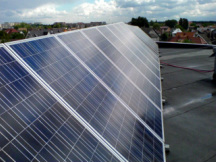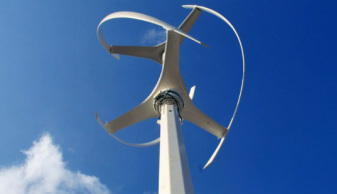URBAN RENEWABLE ENERGY FARM
Organics of Chicago will introduce Chicago to perhaps the most integrated approach to addressing multiple urban, environmental, and alternative energy concerns: the integration of solar panels, wind turbine and geothermal technologies within an extensive urban growing facility – capitalizing on all of the benefits of several alternative technologies. Geothermal technology will allow Organics to maintain an internal year-round temperature of approximately 55 degree Fahrenheit. The wind and solar technologies will provide the remaining electricity to maintain the necessary 72 – 76 degree Fahrenheit for optimal growing.
A portion of the facility will be utilized as an urban renewable energy farm, inclusive of electric generating wind turbines and solar panels located on the rooftop and an internal geothermal heating & cooling system. The organization hopes to supplement from 80% to 100% of the total electricity needed to operate the facility. The farm will be used to not only provide relief to the most expensive cost of an urban farm – electricity – but will be used to educate guests on different renewable energy technologies.
Systems combining wind and solar energy have been made possible by recent technological developments. Organics of Chicago will combine solar and wind renewable technologies in order to capitalize on an increased and consistent energy production. Combined systems are integrated easily into most urban warehouse roof tops and are often linked with a battery-backup system that provides security in case of energy crisis. A natural, negative correlation exists between sun and wind-power generation: when one is high, the other tends to be low. The most obvious difference is between day and night. However, on a larger scale, seasonal changes are equally important. Shorter days and higher average wind speeds limit solar production during winter months, while longer days and ample sunshine work in its favor in the summer. These factors take on greater weight when a battery-backup system is in place. In the type of system going to be utilized by Organics, the energy will be stored in batteries and used when. This is especially true in locations with extreme seasonal variance. Taken together, hybrid wind/solar systems can strike the balance between cost, energy production, and space.
Geothermal energy originates from the heat retained within the Earth since the original formation of the planet, from radioactive decay of minerals, and from solar energy absorbed at the surface. Most high temperature geothermal heat is harvested in regions close to tectonic plate boundaries where volcanic activity rises close to the surface of the Earth. In these areas, ground and groundwater can be found with temperatures higher than the target temperature of the application. However, even cold ground contains heat, below 6 metres (20 ft) the undisturbed ground temperature is consistently at the Mean Annual Air Temperature and it may be extracted with a heat pump.
Like a refrigerator or air conditioner, these systems use a heat pump to force the transfer of heat from the ground to the building. Heat can be extracted from any source, no matter how cold, but a warmer source allows higher efficiency. A ground-source heat pump uses the shallow ground or ground water (typically starting at 10–12 °C or 50–54 °F) as a source of heat, thus taking advantage of its seasonally moderate temperatures. In contrast, an air-source heat pump draws heat from the air (colder outside air) and thus requires more energy.
Ground Source Heat Pumps (GSHP) are NOT geothermal, i.e.,There is no geyser providing heat to be captured. GSHP merely accesses stored solar heat energy in the soil or rock. GSHPs circulate a carrier fluid (usually a mixture of water and small amounts of antifreeze) through closed pipe loops buried in the ground. Single-home systems can be "vertical loop field" systems with bore holes 50–400 feet d or, if adequate land is available for extensive trenches, a "horizontal loop field" is installed approximately six feet subsurface. As the fluid circulates underground it absorbs heat from the ground and, on its return, the warmed fluid passes through the heat pump which uses electricity to extract heat from the fluid. The re-chilled fluid is sent back into the ground thus continuing the cycle. The heat extracted and that generated by the heat pump appliance as a byproduct is used to heat the house. The addition of the ground heating loop in the energy equation means that significantly more heat can be transferred to a building than if electricity alone had been used directly for heating.
Switching the direction of heat flow, the same system can be used to circulate the cooled water through the house for cooling in the summer months. The heat is exhausted to the relatively cooler ground (or groundwater) rather than delivering it to the hot outside air as an air conditioner does. As a result, the heat is pumped across a larger temperature difference and this leads to higher efficiency and lower energy use.
This technology makes ground source heating economically viable in any geographical location.







